We continue the publication of stories by Olga Rozhneva about the convents founded by Elder Ephraim (Moraitis) in the USA. The convent she visited this year by the grace of God is situated in a very picturesque area amid the Sierra Nevada mountains in eastern California, dedicated to the “Life-Giving Spring” icon of the Most Holy Theotokos.
As we were heading for the convent, our road ran across the most beautiful part of California, which has several national parks.
In Sequoia National Park, located close to the convent, travelers are blown away by the giant trees that even have their own names. For example, the General Sherman Tree, the largest tree in the world, is over 2,000 years old, stands 275 feet tall and is over thirty-six feet in diameter!
Sequoia National Park borders the Kings Canyon National Park. The Sierra Nevada (meaning “snowy mountain range” in Spanish) runs approximately 620 miles along the eastern edge of California and offers fascinated tourists views of snow-capped peaks, deep canyons, and emerald green alpine lakes. We were admiring the beauty of orange groves, breathing the sweet smell of blossoming almond trees and the fresh mountain air.
We arrived at the convent late in the evening, but the sisters laid the table for us at the refectory and we enjoyed beet soup, olives, juicy grapefruit, very sweet oranges and other fruits of that fertile land. We couldn’t see the convent well in the darkness, but the nuns warned us that services were held there at nights according to the Athonite typikon.
As do all their pilgrims, we put up at the Ranch of St. Nicholas the Wonderworker near the convent. After a rest we turned on our flashlights and made for the church. During the Liturgy we felt as if we were in heaven, not on earth.
Visiting the convents that were founded by Geronda Ephraim, a spiritual child of the great Elder Joseph the Hesychast from Mt. Athos, is a unique opportunity for women to feel both the spirit of this holy mountain and the holy elder’s prayers through the prayers of his spiritual children.
When we left the church it was dawning, and we were enchanted by the nature around the convent, the cathedral, the icons and paintings depicting scenes from the Gospel. The sisters look after the convent’s garden, and the expanse that stretched in front of us was breathtaking.
We were told that numerous wild animals lived there: American black bears, cougars, and black-tailed deer. American black bears are smaller and less aggressive than Russian brown bears and they run away at the sight of people. However, they are “mischief-makers” and can easily steal chickens, goats or sheep from farms. In addition, they like to grab tourists’ food from unattended backpacks in national parks. That is why all tourists are given out special containers for storing their food and whistles for scaring these “prankish” animals away.
Cougars attack people very seldom, but if you are in their way at night while they are hunting, you can get in trouble. Fortunately we did not encounter any predators, though we did find a scorpion on the floor of the shower stall. We spotted it when it was not too late so it did not sting anyone. After all, there is wild fauna everywhere around this convent!
Abbess Markella kindly agreed to meet and talk with me. On learning that I came from Optina Monastery in Russia, Gerondissa Markella said that she greatly revered the saints of Optina and had read a lot about them. She was very pleased with our gifts from Optina, namely blessed oil, icons and other holy objects.
***
—Dear Gerondissa Markella, could you tell please us how you met Elder Ephraim and came to the convent?
—I was born in 1949 and have known my dear elder since I was very young. I was in search of a spiritual father and was under the spiritual guidance of one priest who, as it turned out, was one of Elder Ephraim’s disciples. And once I heard a voice in a dream saying: ‘The man whom you will meet soon is holy.’ Those words touched my heart so deeply that they made me weep.
Soon after that I met my future spiritual father. During our first meeting Geronda looked at me attentively and told me about men and women in monastic clothes who don’t marry but live by prayer alone and glorify God. It seems that he foresaw my future life path. After those words and his prayers I firmly decided to become a nun.
—And you immediately joined the convent?
—No, I couldn’t do it right away because strong temptations began. The elder invited me to Portaria, to the Convent of Panagia Odigitria near Volos (Greece). Then I was seventeen and the main hindrance was my mother, who would not allow me to become a nun.
Our family was poor. My father died at the age of thirty-five when I was two and a half years old, and my mother never remarried and raised us—me, my sister and my brother—on her own. She wanted to find me a worthy husband and discouraged me from entering a convent. She finally allowed me to receive the tonsure two years later when I was nineteen.
Later, when my younger sister became a student and began to come home late in the evening, my mother agreed that my decision to become a nun had been a wise one as young people had numerous temptations at that time.
—Many of those seeking monastic life hesitate because they are not sure if it is their life’s path. Did you have any doubts about your life’s path?
—I have never had the slightest doubt… You feel that you love God and the Holy Theotokos with all your heart, and want to serve them wholeheartedly, and to give your life to them. So you take up monasticism. You have no hesitation; rather, you have determination and zeal. If you have this determination, then it is your path because God alone can kindle this flame in your heart and call you to monastic life.
—Mother Markella, how did your monastic life begin and who was your first spiritual mentor?
—I entered the convent at Portaria when I was very young and I came to love its abbess, Gerondissa Macrina (secular name: Maria Vassopoulou; 1921–1995). She was a unique, blessed eldress who was chosen by God from her mother’s womb. She lost her parents in her early childhood, endured many sorrows, the maladies and horrors of war, worked hard, and gained numerous spiritual gifts by her fervent prayers.
—I read what Elder Ephraim wrote of Blessed Macrina: “She had a wondrous purity of mind. I have never seen such pure thoughts in any other person.”1
—It was the fruit of her prayers. Gerondissa Macrina prayed much and indeed she never ceased to pray; even in her sleep she continued to count her prayer knots with her fingers. I well remember that her lips produced a pleasant odor because she repeated Jesus Prayer unceasingly. Today we will hardly be able to find an ascetic who can be compared with her, whose spiritual gifts and experiences are similar to hers. Not only monks and nuns but also lay-people—lawyers, doctors—sought Blessed Macrina’s advice…
—Can you share some instructions of this blessed eldress with us?
—For example, if one or another nun is sick, I must take care of her by secretly taking her linen and washing it without being noticed. And at that time there were many elderly and sick nuns in Portaria. The eldress taught me, “Don’t tell anybody about your intentions. But whenever you are going to wash your own linen, take the sick nun’s linen in secret and wash it as well.”
The gerondissa taught us to perform acts of charity and not to “shout it from the housetops,” as it were. Mother Macrina herself did not say many words of love, instead preferring to display it in practice.
She was clairvoyant, she had a rich spiritual experience, and she saw visions of Paradise and hell, heard sinners gnashing their teeth in hell and, therefore, prayed a lot. Once the spiritual world has been revealed to a person, he can no longer be careless.
—Mother Markella, did you see any evidence of Eldress Macrina’s clairvoyance yourself?
—Whenever I was doing something wrong, she asked me to come to her cell. Even in cases where she couldn’t possibly have known about my mistakes she would immediately invite me to her cell. I would reveal all my thoughts and deeds to her and then was relieved.
—Could you tell us about your spiritual father, Elder Ephraim?
—When the elder was hearing our confessions, the fragrance filled the confessional. He heard the sisters’ confessions until four in the morning and the Jesus Prayer was continually on his lips. Geronda Ephraim has always been giving of himself to people. Every evening he would speak with us about obedience and the spiritual life. He had no time to read about these things—they are in his heart. His sermons would flow like a river and last an hour or two. Blessed Macrina could do the same—these people didn’t need any books because they were inspired directly by the Holy Spirit. I am unworthy of knowing these people, but the Lord deigned to send them to me.
Now my spiritual father is advanced in years and doesn’t hear confessions any more, but I and Gerondissa Ephremia, Abbess of the Holy Archangel Michael’s Convent in Thasos Island (Greece), still reveal our thoughts to each other. At the convent we don’t sin by deed, but we must fight the inner spiritual struggle continually.
Once with the blessing of Elder Ephraim I moved from Portaria to the Convent of the Archangel Michael in Thasos. Abbess Macrina loved all her nuns as if she were their mother and I didn’t want to leave her; but Elder Ephraim had developed a well-thought-out plan… deep in my heart I didn’t want to go to America, but as you know, cutting off of your self-will and obedience are the first and foremost rules of monastic life.
—And how do you communicate with your spiritual father now?
—I am always in contact with Fr. Ephraim. We have developed a spiritual bond with him. I have been under his spiritual guidance for fifty-one years now. Geronda Ephraim knows everything about me, including the things I am not able to tell him. Last July I travelled to St. Anthony’s Monastery in Arizona to see him, but the elder said to me, “What are you doing here? You don’t need to make such long journeys! I am always with you spiritually.’
And I am aware that the elder’s prayers for me and my sisters are very strong. As soon as I ask for his help in my mind I find solutions to all my problems. Our spiritual bond is very strong. Geronda Ephraim knows and understands everything that ever happens at our convent and our state of affairs.
—Dear Gerondissa Markella, could you tell us the story of the foundation of your convent in more detail?
—Over the past twenty years, Elder Ephraim has opened as many as eighteen Greek monastic communities across America and most of them are convents. They are located in various places and states in America. The place for this convent was chosen by Metropolitan Anthony (Gergiannakis) of San Francisco (1935-2004). He thought highly of Geronda Ephraim and once said to me, “One day the name of Elder Ephraim and his monasteries will be written in the history of America.”
Imagine! Not only in the history of Orthodoxy in America, but in the whole history of America!
The metropolitan asked Elder Ephraim to send nuns to the convent and the latter blessed us to come here. Back in 1993, there were only the mountains and a ranch here. We lived in a small house below for the first ten years. Two of us came from Greece and several other sisters were Greeks born in the USA. We had virtually nothing, no food, and that period was very hard for our community.
Metropolitan Anthony hoped that the owners of the ranch would support us, but nevertheless the first year was extremely difficult. We had only eight bags full of spiritual literature and nothing else—no belongings, no clothes! It was God that provided us with everything.
We withstood those hardships and they were for our good as they taught us to pray. In 1994, through the prayers of Geronda Ephraim the first pilgrims began to come to us and our situation gradually improved. Little by little I learned to be a gerondissa.
—Today after the service we looked around the convent. It is superb! How was it built?
—As long as Metropolitan Anthony was alive, benefactors donated their money for its construction because they trusted him. He wanted to beautify and decorate our convent and to have monastic buildings along the perimeter walls.
But the metropolitan died of Burkitt's lymphoma in 2004 at the age of sixty-nine. We visited him at the hospital and he said to me, “I am dying, and you must complete the convent. You are to translate my vision into reality.”
He suffered an artery rupture while undergoing surgery and died of loss of blood.
After the metropolitan’s death, the flow of donations stopped and we had no money for the monastery’s construction. But we had his blessing, so the sisters set to work. The nuns made designs and drew them themselves. We submitted the designs to the authorities in 2009 and it took us five years to get permission. But even with the construction permit we had no idea where we would get money to build. I prayed to the Mother of God for an opportunity to start the work.
Then the following miracle occurred: Brother Nektarios Yangson, the keeper of the myrrh-streaming Iveron icon of the Holy Theotokos, brought us the icon from Hawaii and on the feast of the Dormition, at seven in the morning, I prayed before it in the chapel. At nine o’clock, during the Eucharist, people called us concerning our designs. After taking Communion, one of our sisters went to the county to learn that our plans and designs had finally been approved! We were very happy!
Brother Nektarios told us that the day before he had seen the Queen of Heaven Herself in a crown come out of the iconostasis and say, “All will be done tomorrow!”
He had known nothing about our designs and that we had been waiting for their approval for such a long time. And he experienced that miraculous vision.
So, you see, the Most Holy Virgin arranged everything and “built” our convent Herself. Thus She is the true Abbess of our community. Shortly before those events a bishop from Greece had visited us; he was Metropolitan Anthony’s friend. He walked around the convent’s territory where we had nothing but cement. I said, sighing, “Oh, how will we be able to build everything we need?’ And he answered, “Don’t worry! The Mother of God will do it!”
—Can you tell us about the life of your community today?
—All the monasteries and convents founded by Elder Ephraim follow the strict Athonite typikon, and the sisters practice the Jesus Prayer. Services are held only in Greek. This is Geronda Ephraim’s blessing so that the Greeks living in the USA may not forget their mother tongue—the language the Gospel was written in.
We keep rejoicing at the convent because Christ and the Mother of God are with us every day. However, our spiritual warfare is constant; but we try to be with God and move forward—we seek salvation and the Heavenly Kingdom.
We labor during the daytime and repeat the Jesus Prayer while working. Then we have a short rest in the evening and get up for our private prayer rule at one o’clock in the morning: reciting the Jesus Prayer on our prayer ropes, with prostrations, reading a chapter from the Gospel, the canon and akathist to the Mother of God. The private prayer rule is followed by a service at the church. Services are held between three and six in the morning. After the night service we go to bed and after two hours of sleep we go and perform our obediences. The sisters sew vestments, paint icons, make soaps, creams, candles, incense, sing in the choir, and have duties in the church, the convent’s garden and the refectory.
Our convent is situated in the mountains far from cities and towns (the nearest town is Dunlap, California). So, on Sundays we begin our services later than usual—at half past eight—so that our parishioners and pilgrims can arrive in time and pray with us. After the Sunday service we share breakfast with our parishioners, organize spiritual talks and then have a short rest. We always treat all guests to our food.
—We arrived very late last night, but the sisters offered us a delicious supper. We sincerely thank you for your hospitality, dear Gerondissa Markella!
—You are welcome! We love Russians and appreciate them! Their life is so difficult, but they love God, love churches and venerate holy icons nevertheless. And we really appreciate that! The New Martyrs of the Russian Church have been praying for Russia. Although they were born and raised in an atheist state, they prayed and obeyed the commandments of God.
I wish all those reading this talk to make efforts in order to have strong families, to avoid divorce, and become closer to God!
—We thank you from the bottom of our hearts, dear Gerondissa Markella!
—May God keep you!




























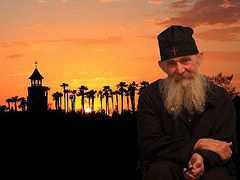
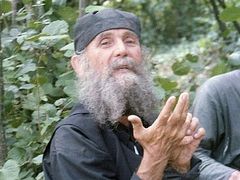
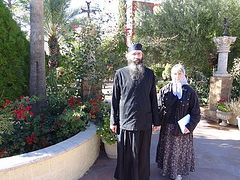
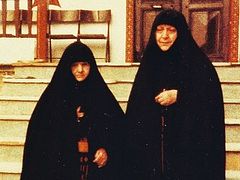
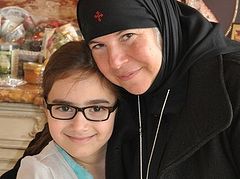
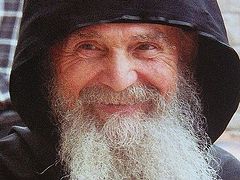
“As we saw from the few examples cited above—and there are countless others—the Orthodox faithful did not mince words, nor were they afraid to take immediate action when they ascertained that their bishop had strayed from Orthodoxy. Inevitably, there were those who found fault with this “extreme” course of action. The latter were not so much disturbed by the heresy of their bishop as they were by the words and actions of the “zealots,” as they usually labeled the conscientious flock.”
Panayotis has “found fault” and is not in the least disturbed by the behavior of his bishops, but rather seeks to deflect us away
1) You are not using righteous judgement: ‘Greek is the language of wolves’, ‘the only good thing are the monasteries’, etc.
2) Thanks for the link to the great article but it is not relevant to your points and even refutes them because it provides solid counsel without resorting to insults, accusations, περιφρονησις or υπεροψια.
3) I don’t think it would be courteous to other readers to continue our off topic clash here so I will have to back out now but feel free to contact me through other means if you wish. May our Panagia be with you!
“Every evening he would speak with us about obedience and the spiritual life. He had no time to read about these things—they are in his heart. His sermons would flow like a river and last an hour or two. Blessed Macrina could do the same—these people didn’t need any books because they were inspired directly by the Holy Spirit.”
This is the kind of theology that is needed most today.
You can find Geronda’s remarkable teaching on slander and condemnation directly on this very site. I trust that you will find it as enlightening as I did.
Fr.Ephraim left GOARCH and joined ROCOR in the 90's. Why did he do that if he was so happy with the state of "hellenic christianity"? Father Ephraim is a man who has advanced above ethic boundaries and seeks a home where Orthodoxy can be expressed in its purest form. The Greek Bishops in the USA want modernism, ecumenism and materialism. This is a fact that you cant silence! Greek is the chosen language of today's wolves!
With that said, it's best to skip the comments section which has truly have become a platform for prelest and sends a poor message to the outside world. Geronda Ephraim, his synodeia and their spiritual children would never say that the only thriving examples of Hellenic Christianity are the monasteries. Never. Oυδείς αναμάρτητος.
I implore Anthony to show some of his posting history to his spiritual father because we don't know when the hour of death will come to take us along with the filthy garment of prelest to the grave.